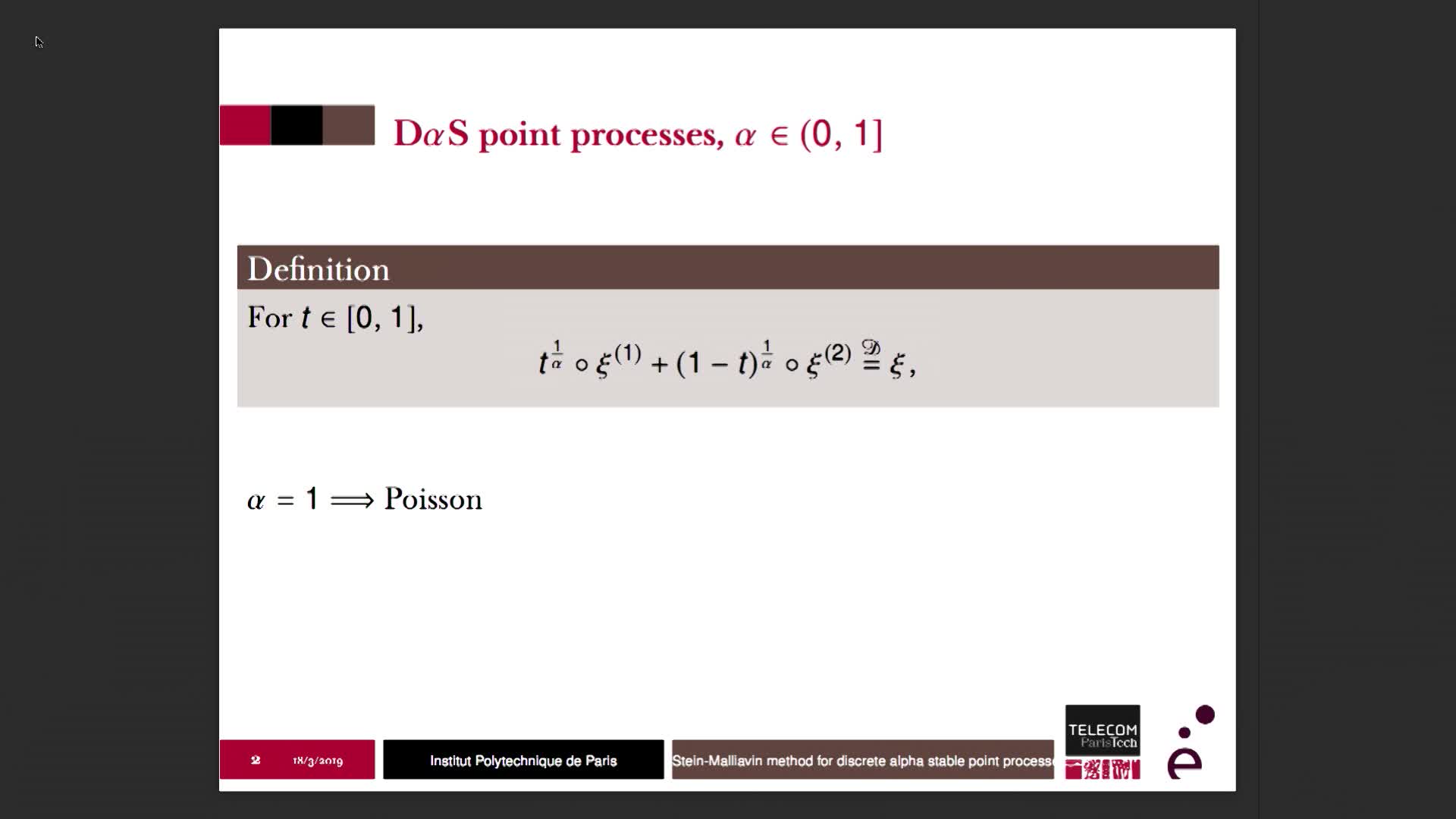Notice
Sampling cluster point processes: a review (workshop ERC Nemo Processus ponctuels et graphes aléatoires unimodulaires)
- document 1 document 2 document 3
- niveau 1 niveau 2 niveau 3
Descriptif
The theme of this talk is the sampling of cluster and iterated cluster point processes. It is partially a review, mainly of the Brix–Kendall exact sampling method for cluster point processes and its adaptation by Moller and Rasmussen to Hawkes branching point processes on the real line with light-tail fertility rate. A formal proof via Laplace transforms of the validity of the method in terms of general clusters that are not necessarily point processes fits this purpose and allows to include the exact sampling of Boolean models. The main novel aspect of this review is the extension of the above sampling methods to non-Poissonian germ point processes.
Thème
Documentation
Documents pédagogiques
Dans la même collection
-
Stein-Malliavin method for discrete alpha stable point processes (workshop ERC Nemo Processus ponct…
DecreusefondLaurentThe notion of discrete alpha-stable point processes generalizes to point processes the notion of stable distribution. It has been introduced and studied by Davydov, Molchanov and Zuyev a few
-
Strict monotonicity of percolation thresholds under covering maps (workshop ERC Nemo Processus ponc…
MartineauSébastienPercolation is a model for propagation in porous media that as introduced in 1957 by Broadbent and Hammersley. An infinite graph G models the geometry of the situation and a parameter p
-
Comments and problems regarding large graphs. (workshop ERC Nemo Processus ponctuels et graphes alé…
BenjaminiItaiWe will discuss a couple of results and questions regarding the structure of large graphs. These include vertex transitive graphs, expanders and random graphs.
-
Eternal family trees and dynamics on unimodular random graphs (workshop ERC Nemo Processus ponctuel…
Haji MirsadeghiMir OmidThis talk is centered on covariant dynamics on unimodular random graphs and random networks (marked graphs), namely maps from the set of vertices to itself which are preserved by graph or
-
On the modified Palm version (workshop ERC Nemo Processus ponctuels et graphes aléatoires unimodula…
ThorissonHermannThe Palm version of a stationary random measure is an important tool in probability. It is however not well known that there are in fact two Palm versions, with related but different
-
Subdiffusivity of random walks on random planar maps, via stationarity (workshop ERC Nemo Processus…
CurienNicolasRandom planar maps have been the subject of numerous studies over the last years. They are instance of stationary and reversible random planar maps exhibiting a non-conventional geometry at
-
Spectral embedding for graph classification (workshop ERC Nemo Processus ponctuels et graphes aléat…
LelargeMarcLearning on graphs requires a graph feature representation able to discriminate among different graphs while being amenable to fast computation. The graph isomorphism problem tells us that no
-
A stable marriage between order and disorder (workshop ERC Nemo Processus ponctuels et graphes aléa…
LastGünterStable matchings were introduced in a seminal paper by Gale and Shapley (1962) and play an important role in economics. Following closely Holroyd, Pemantle, Peres and Schramm (2009), we shall
-
A notion of entropy for limits of sparse marked graphs (workshop ERC Nemo Processus ponctuels et gr…
AnantharamVenkatBordenave and Caputo (2014) defined a notion of entropy for probability distributions on rooted graphs with finite expected degree at the root. When such a probability distribution \rho has finite BC
-
Central Limit theorem for quasi-local statistics of point processes with fast decay of correlations…
We shall consider Euclidean stationary point processes which have fast decay of correlations i.e., their correlation functions factorize upto an additive error decaying exponentially in the
-
Emergence of extended states at zero in the spectrum of sparse random graphs (workshop ERC Nemo Pro…
SalezJustinWe confirm the long-standing prediction that c=e≈2.718 is the threshold for the emergence of a non-vanishing absolutely continuous part (extended states) at zero in the limiting spectrum of the
-
Absence of percolation for Poisson outdegree-one graphs (workshop ERC Nemo Processus ponctuels et g…
CoupierDavidA Poisson outdegree-one graph is a directed graph based on a marked Poisson point process such that each vertex has only one outgoing edge. We state the absence of percolation for such graphs













